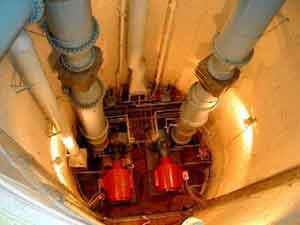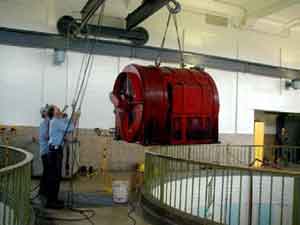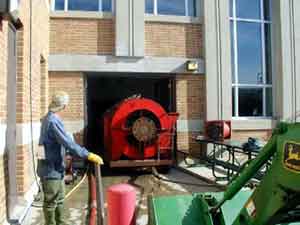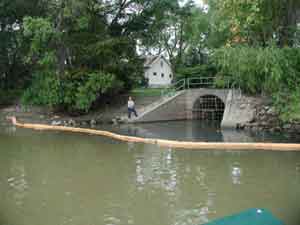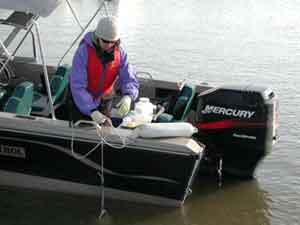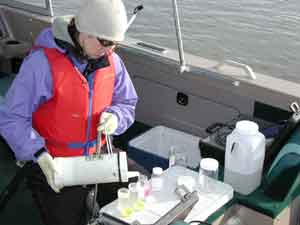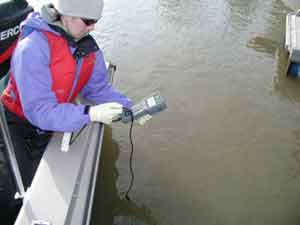North End Water Pollution Control Centre (NEWPCC)
September 16 - 19, 2002 shutdown summary reportThe North End Water Pollution Control Centre (NEWPCC), located at 2230 Main Street, treats sewage generated from the north and central parts of the city, representing about 70% of Winnipeg, or approximately 370,000 residents. Treated wastewater from NEWPCC is discharged to the Red River, which flows north to Lake Winnipeg.
What happened?
- At about 1:15 p.m. on Monday, September 16, 2002, one of the six pumps shut down during maintenance. This mechanical failure shut down the plant.
- Raw sewage flowed into all three 54-foot deep pump wells, which contain two motorized pumps each. The wells are connected, and sewage immersed all six pumps. The sewage could no longer be pumped through the regular wastewater treatment processes.
- At about 5:00 p.m., sewage began to overflow through a number of combined sewer outfalls directly into the Red River at a rate of about 185,000 cubic metres per day, or approximately 1% - 1.5% of the river flow.
- Manitoba Conservation, Manitoba Health, Environment Canada and Winnipeg Regional Health Authority were notified promptly.
- The first in a series of daily press releases advising the community of the plant shut down and its effect was issued on September 16 at approximately 5:38 p.m.
What caused the mechanical failure?
A broken guide inside a large suction valve caused the mechanical failure. The valve weighs approximately 8,000 pounds, and is about 12 feet high, 30 inches thick and 50 inches wide. Inside the valve, a cast iron disk, which is 36 inches in diameter, moves up and down along guides as the valve opens and closes. One of the guides was broken, causing the disk to twist and be lodged open by about 12 inches. As there is no obvious reason why the guide broke, we have hired a consultant to study and report on the failure.
When did the raw sewage stop flowing to the river?
Repairs to the plant progressed quickly, and 57 hours later at approximately 2:00 a.m. on September 19, full wastewater treatment resumed and all flows to the river had ceased.
- Working around the clock, staff had three motors removed on September 17, and sent them to be cleaned, dried, and serviced.
- By 12:01 a.m. on September 19, one pump was working. Starting at 1:46 a.m., there was a gradual reduction in the amount of sewage flowing to the river.
- At approximately 2:00 a.m., a second pump was working. Only two of the six main pumps are required to pump normal plant flows.
- Just over three hours later, by about 5:00 a.m., all flows to the river had ceased.
- Two additional pumps were ready if needed by September 21.
- A fifth pump was operational by October 4.
- The sixth pump will remain out of service until the investigation into the cause of the mechanical failure is complete.
- The plant has performed well since it was placed back into service.
What steps were taken to minimize the impact on the river water quality?
Booms were installed on September 17 at eight outfall locations to trap any floating sewage debris. The booms were checked daily and any debris that had accumulated was removed.
What steps were taken to monitor river water quality?
We routinely sample and test river water quality along the Red River throughout the year on a biweekly basis at six locations. In response to the plant shut down, we expanded our normal testing program as follows:
- Staff began daily tests of the river water beginning the morning of September 17.
- The testing program was expanded to include up to 14 locations, beginning upstream in Winnipeg at the Provencher Bridge, and continuing downstream past Selkirk.
- The number of sampling locations was reduced starting September 24, and after September 25, the normal river water quality testing schedule resumed.
We shared our test results with Manitoba Conservation, who also conducted river water quality tests ![]()
![]() (pdf - 419kb) as a result of the shut down.
(pdf - 419kb) as a result of the shut down.
What was the impact on river water quality?
The following is a summary of the dissolved oxygen and fecal coliform test results at the sampling locations:
Dissolved oxygen
- River dissolved oxygen levels in the Winnipeg area, as well as downstream of Winnipeg, always met provincial water quality objectives and were within the acceptable range to support healthy aquatic life at all times.
- Test results showed that the lowest dissolved oxygen level in the river was 5.4 mg/L, reported immediately upstream of Lockport on September 20. Downstream of the locks, dissolved oxygen levels never fell below 8.0 mg/L. As of September 21, oxygen levels at Lockport were back up 8.4 mg/L, which is well within the normal range.
Fecal coliform
- The highest recorded value for fecal coliform in the Red River, during the period of untreated discharge, was on September 18 at one location at the Chief Peguis Bridge.
- By September 24 (five days after the uncontrolled discharge was stopped), fecal coliform levels in the Red River had returned to normal.
No communities downstream of Winnipeg on the Red River use the river as a source of drinking water.
The Province maintained two of their ongoing recommendations:
- River water should not be used at any time for recreation purposes such as swimming, or for personal use such as drinking and irrigating ready-to-eat produce.
- Residents were advised that they could continue to fish on the Red River as long as they followed proper handling and processing procedures, which are recommended at all times.
What are the next steps?
The Water and Waste Department has already started an internal review of the event. In addition, we are also:
- Conducting a study to find a way to isolate each of the three wells.
- Analyzing all three wastewater treatment plants to determine if improvements can be made to prevent future unplanned plant shut downs.
There are also three other reviews:
City of Winnipeg
An independent engineering firm, Associated Engineering (B.C. Ltd.) is conducting an impartial review to identify the root cause(s) of the event and recommend measures to reduce the chances of future events. Their report is expected to be completed in December 2002.Province of Manitoba
On October 3, 2003, the Minister of Conservation requested that the Clean Environment Commission hold public hearings regarding the City of Winnipeg's wastewater collection and treatment systems. The Commission findings and recommendations are available in their final report
regarding the City of Winnipeg's wastewater collection and treatment systems. The Commission findings and recommendations are available in their final report 
 (pdf - 738kb) and include recommendations on:
(pdf - 738kb) and include recommendations on:- The reliability of the City's systems, especially the backup capability of the systems to prevent a discharge of inadequately treated sewage to the rivers during malfunctions.
- The appropriate ammonia, nutrient, combined sewer overflow and microbiological limits on effluent from the City's systems necessary to protect the aquatic environment and recreational activities, including in Lake Winnipeg.
- The current and planned effectiveness of the City's systems in treating wastewater to achieve the discharge limits.
- The adequacy of the City's plans and schedule for upgrading its systems
- The adequacy of processes being followed in reviewing those plans and schedules.
Environment Canada, Environmental Protection Branch
Environment Canada is investigating the incident under the authority of the Fisheries Act.
Images of the event
|
|
|
|
|
|
|
This page was last updated on April 15, 2024 |
|

